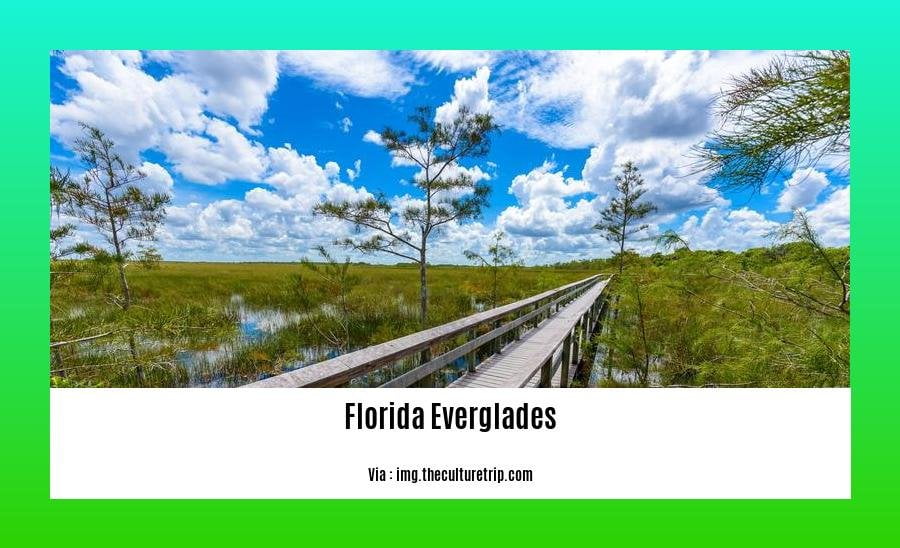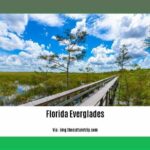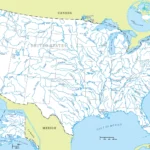Prepare to delve into the intriguing realm of the Florida Everglades, a unique ecosystem that offers a captivating blend of diverse plant and animal life in the [[Facts about Florida Everglades]: Unveiling the Wonders of a Unique Ecosystem]. Eager to unravel the secrets of this remarkable natural treasure? Join us as we embark on an exciting journey to discover the wonders that lie within the River of Grass.
Key Takeaways:
Florida Everglades is one of the largest continuous stand of sawgrass prairie in North America.
The Everglades is internationally recognized for its unique ecosystem and is designated as a World Heritage Site, a Biosphere Reserve, a Wetland of International Significance, and an Outstanding Florida Water.
It is a crucial water recharge area for all of South Florida through the Biscayne aquifer.
The Everglades is home to a diverse array of plants and animals, including many endangered species, and draws a large number of ecotourists.
Traditionally, the Everglades was the home of Native Americans and was a significant battleground during the Seminole Wars.
Covering an area of 1.509 million acres, the Everglades welcomes at least one million visitors from various parts of the world each year.
Located near human settlements like Miami and Fort Lauderdale, the Everglades faces numerous challenges such as pollution, development, and the impact of climate change.
Facts about Florida Everglades
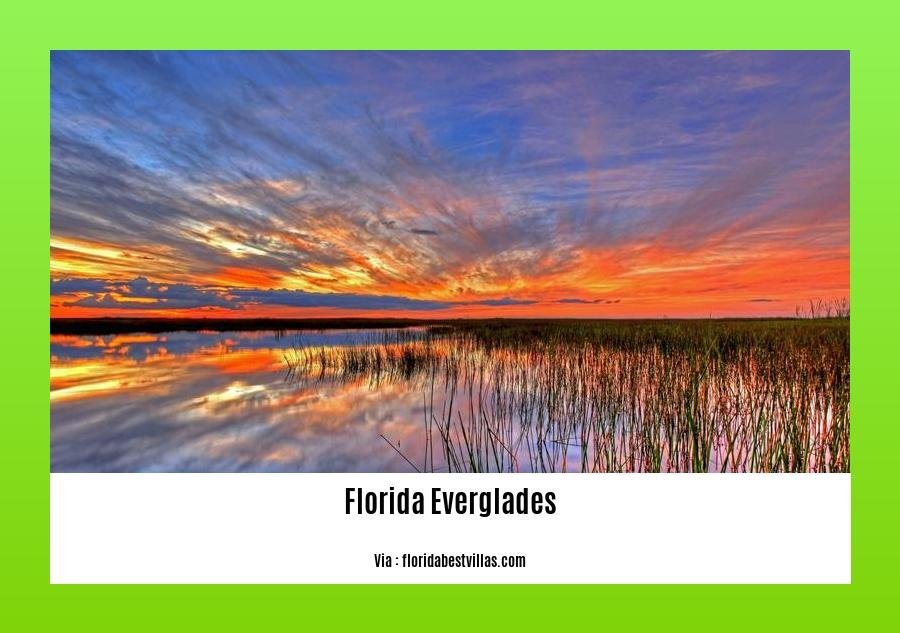
The Florida Everglades, a natural wonder of global significance, is a mosaic of diverse ecosystems harboring an array of fascinating secrets and ecological marvels. Let’s delve into some intriguing facts about this unique wetland ecosystem:
Largest Sawgrass Prairie in North America
The Everglades boasts the distinction of hosting North America’s largest contiguous sawgrass prairie, stretching across a vast expanse of 1.509 million acres. This unique habitat, characterized by its dense growth of sawgrass, provides a vital haven for numerous plant and animal species, contributing to the ecosystem’s rich biodiversity.
UNESCO World Heritage Site and More
Recognizing its exceptional natural and cultural significance, UNESCO has designated the Everglades as a World Heritage Site, a Biosphere Reserve, a Wetland of International Significance, and an Outstanding Florida Water. These prestigious designations underscore the global importance of the Everglades and the urgent need for its conservation.
Vital Water Recharge Area
The Everglades functions as a natural water purifier and storage system, recharging the Biscayne aquifer, a crucial source of drinking water for millions of South Florida residents. This vital role highlights the Everglades’ importance beyond its ecological boundaries, contributing to the well-being of human communities.
Diverse Flora and Fauna
The Everglades is a biodiversity hotspot, providing shelter to a diverse assemblage of plants, animals, and birds, many of which are found nowhere else on Earth. This includes endangered species such as the Florida panther, the Everglades snail kite, and the West Indian manatee, making the Everglades a sanctuary for rare and threatened species.
Ecotourism Destination
The Everglades’ unique beauty and rich biodiversity make it a popular destination for ecotourism, attracting visitors from around the world. Airboat tours, hiking trails, and wildlife observation opportunities allow visitors to immerse themselves in the natural wonders of the Everglades, fostering a deeper appreciation for its ecological significance.
Challenges Facing the Everglades
Despite its ecological significance, the Everglades faces numerous challenges, including pollution from agricultural runoff, urban development, and climate change. These threats jeopardize the health of the ecosystem and the survival of its diverse species, demanding urgent conservation efforts to protect this natural treasure for future generations.
For an enriching travel experience, discover 10 fun facts about the Dominican Republic that will make your trip unforgettable. In addition, Argentina offers intriguing insights. Explore 3 interesting facts about Argentina to unravel its hidden gems. For a more in-depth understanding, delve into 5 fascinating facts about Argentina that will captivate your imagination.
Unique Hydrology
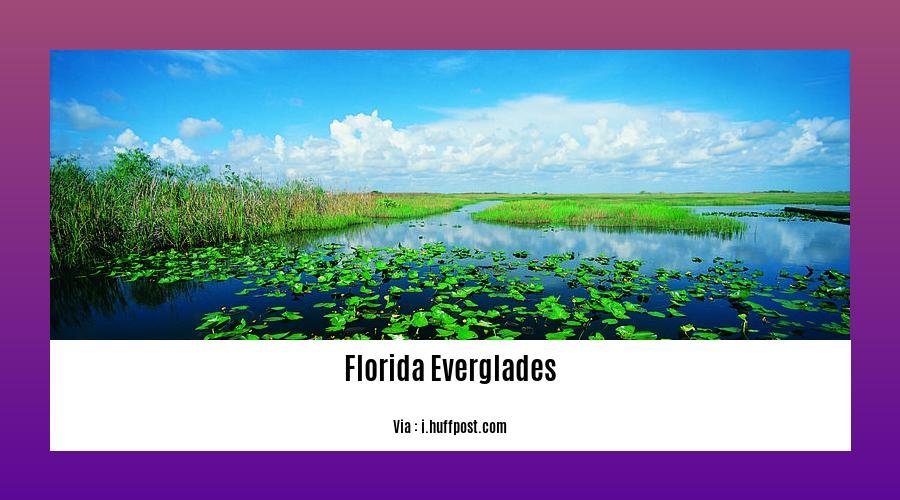
Picture a colossal expanse, like a boundless tapestry woven from the threads of land and water. This is the land of the Florida Everglades, a landscape pulsating with life, shaped by the heartbeat of its unique hydrology.
The Everglades is more than just a wetland; it’s an intricate dance between water and land, a living testament to the power of water shaping the contours of life.
Sources:
– Hydrologic Activity – Everglades National Park (U.S. National Park Service)
– Ecology of Everglades National Park | U.S. Geological Survey]
**Everglades National Park is a living mosaic of aquatic ecosystems, where the flow of water, more so than the solidity of land, determines the fate of the inhabitants. Water sculpts the terrain, creates habitats, and shapes the livelihoods of the creatures that call this wetland home.
The Everglades and the uniquely flat terrain give life to a dynamic dance of water. With no mountains to hold back its flow, water flows gently, or not at all, across the landscape, creating a mosaic of marshes, swamps, sloughs, and tree islands.
The Everglades has a unique water management system known as the Water Conservation Areas (WCAs). These WCAs allow water to flow naturally through marshes, sloughs, and tree islands before reaching the Everglades National Park. This system, mimics the natural water flow patterns of the Everglades.
The Everglades’ unique hydrology shapes a diverse ecosystem of unparalleled beauty. It’s a sanctuary for a myriad of life forms adapted to this water-driven world, from the iconic American crocodile to the elusive snail kite.
Key Takeaways:
- The Everglades’ unique hydrology creates a mosaic of aquatic ecosystems, shaping the terrain and habitats for its diverse inhabitants.
- The flat terrain and the absence of mountains allow water to flow gently across the landscape, forming a dynamic mosaic of marshes, swamps, sloughs, and tree islands.
- The Everglades’ Water Conservation Areas (WCAs) mimic the natural water flow patterns, ensuring the health and sustainability of the ecosystem.
- The unique hydrology of the Everglades fosters a rich biodiversity, supporting a wide range of plant and animal species adapted to its water-driven environment.
Threatened Ecosystem: A Delicate Balance in the Florida Everglades
The Florida Everglades, a unique and diverse ecosystem, faces numerous threats that jeopardize its delicate balance.
Reduced Water Flow:
Human activities, such as draining and diverting water for agriculture, have significantly reduced the flow of water into the Everglades. This has disrupted the natural hydrology of the ecosystem, leading to changes in plant and animal communities.
Nutrient Pollution:
Agricultural runoff carries excess nutrients, such as nitrogen and phosphorus, into the Everglades. These nutrients can cause algal blooms, which block sunlight and deplete oxygen levels in the water, harming aquatic life.
Invasive Species:
Non-native species, such as the Burmese python and the melaleuca tree, have been introduced into the Everglades, either intentionally or accidentally. These species compete with native plants and animals for resources, disrupting the ecosystem’s natural balance.
Sea-Level Rise:
Rising sea levels due to climate change threaten to inundate coastal areas of the Everglades. This can lead to saltwater intrusion into freshwater wetlands, harming plant and animal communities adapted to freshwater conditions.
Key Takeaways:
– The Everglades ecosystem is facing severe threats from reduced water flow, nutrient pollution, invasive species, and sea-level rise.
Human activities, such as draining and diverting water for agriculture, have significantly altered the natural hydrology of the Everglades.
Agricultural runoff carries excess nutrients into the Everglades, leading to algal blooms and reduced oxygen levels in the water.
Non-native species compete with native plants and animals for resources, disrupting the ecosystem’s delicate balance.
Rising sea levels threaten to inundate coastal areas of the Everglades, leading to saltwater intrusion and harming freshwater plant and animal communities.
Citations:
“Threats to the Everglades – South Florida Aquatic Environments.” Florida Museum, University of Florida, Accessed 7 Mar. 2023.
“Everglades National Park | World Heritage Outlook.” IUCN World Heritage Outlook, Accessed 7 Mar. 2023.
Restoration Efforts: Reviving the Everglades’ Natural Splendor
When we talk about restoring the Everglades, we aren’t just mending a broken ecosystem; we’re reviving a vital part of Florida’s identity, a beating heart that pumps life into the region. It’s a herculean task, one that spans decades and involves multiple agencies, but it’s a labor of love for those who cherish this unique ecosystem. So, what’s all the fuss about? Let’s delve into the hows, whys, and wows of the Everglades restoration efforts.
The Why: A Symphony of Benefits
The Everglades restoration isn’t just about saving a pretty face; it’s about securing a future for South Florida. This vast ecosystem provides a wealth of services that we often take for granted. It acts as a natural filter, purifying water before it reaches our homes and businesses. It’s a guardian against floods, absorbing excess water like a giant sponge. And of course, it’s a haven for wildlife, a place where endangered species find refuge and thrive. By restoring the Everglades, we’re not just healing a landscape; we’re investing in our well-being, our economy, and the future of our children.
The How: A Multifaceted Approach
Restoring the Everglades is like solving a thousand-piece puzzle, where each piece represents a different project, each contributing to the bigger picture. The Comprehensive Everglades Restoration Plan (CERP) is the guiding force behind these efforts, a multibillion-dollar initiative that involves federal, state, tribal, and local governments working in unison. From removing dams and levees to restoring wetlands and improving water quality, CERP aims to bring back the natural flow of water, the lifeblood of the Everglades.
The Challenges: A Daunting Task
The road to restoration is paved with challenges, and the Everglades is no exception. Balancing the needs of the environment, agriculture, and urban development is like walking a tightrope. Invasive species, climate change, and pollution further complicate the picture. But, like the river of grass that meanders through the Everglades, the restoration efforts persist, adapting and evolving to overcome these hurdles.
Key Takeaways:
Restoration Efforts: The CERP is a multibillion-dollar project involving multiple agencies and stakeholders, aiming to restore the natural water flow and ecological integrity of the Everglades.
Challenges: Balancing environmental, agricultural, and urban needs, combatting invasive species, climate change, and pollution are among the challenges faced in Everglades restoration.
Benefits: The restoration efforts aim to improve water quality, reduce flood risks, protect endangered species, and sustain the unique ecosystem that supports South Florida’s economy and quality of life.
Sources:
FAQ
Q1: What is the significance of the Everglades ecosystem?
A1: The Everglades ecosystem is a crucial habitat for numerous plant and animal species, including many endangered species. It is also a major source of freshwater for South Florida and plays a vital role in flood control and water storage.
Q2: What are some of the challenges facing the Everglades?
A2: The Everglades faces several challenges, including pollution from agricultural runoff, habitat loss due to urban development, and climate change.
Q3: What is being done to restore the Everglades?
A3: A comprehensive restoration effort is underway to restore the natural water flow of the Everglades and improve water quality. The Comprehensive Everglades Restoration Plan (CERP) is a multibillion-dollar project that is expected to take several decades to complete.
Q4: What can individuals do to help protect the Everglades?
A4: There are several things that individuals can do to help protect the Everglades, such as reducing their water consumption, supporting conservation organizations, and educating others about the importance of this unique ecosystem.
Q5: What makes the Everglades unique?
A5: The Everglades is unique because it is the largest subtropical wilderness in the United States and is home to a diverse array of plant and animal life. It is also a vital water resource for South Florida and is a popular destination for ecotourism.
- Unlock Elemental 2 Secrets: Actionable Insights Now - April 2, 2025
- Lot’s Wife’s Name: Unveiling the Mystery of Sodom’s Fall - April 2, 2025
- Photocell Sensors: A Complete Guide for Selection and Implementation - April 2, 2025
